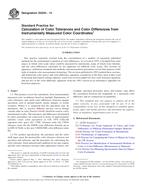Potrebujeme váš súhlas na využitie jednotlivých dát, aby sa vám okrem iného mohli ukazovať informácie týkajúce sa vašich záujmov. Súhlas udelíte kliknutím na tlačidlo „OK“.
ASTM D2244-14
Standard Practice for Calculation of Color Tolerances and Color Differences from Instrumentally Measured Color Coordinates
Automaticky preložený názov:
Štandardná prax pre výpočet Farebné tolerancií a farebné rozdiely z inštrumentálnych Nameraná farebnými súradnicami
NORMA vydaná dňa 1.5.2014
Informácie o norme:
Označenie normy: ASTM D2244-14
Poznámka: NEPLATNÁ
Dátum vydania normy: 1.5.2014
Kód tovaru: NS-19752
Počet strán: 11
Približná hmotnosť: 33 g (0.07 libier)
Krajina: Americká technická norma
Kategória: Technické normy ASTM
Anotácia textu normy ASTM D2244-14 :
Keywords:
color, color difference, color metrics, color spaces, color tolerances, ICS Number Code 17.180.20 (Colours and measurement of light)
Doplňujúce informácie
| Significance and Use | ||||||||||||||
|
5.1 The original CIE color scales based on tristimulus values X, Y, Z and chromaticity coordinates x, y are not uniform visually. Each subsequent color scale based on CIE values has had weighting factors applied to provide some degree of uniformity so that color differences in various regions of color space will be more nearly comparable. On the other hand, color differences obtained for the same specimens evaluated in different color-scale systems are not likely to be identical. To avoid confusion, color differences among specimens or the associated tolerances should be compared only when they are obtained for the same color-scale system. There is no simple factor that can be used to convert accurately color differences or color tolerances in one system to difference or tolerance units in another system for all colors of specimens. 5.2 Color differences calculated in ΔECMC or ΔE00 units are highly recommended for use with color-differences in the range of 0.0 to 5.0 ΔE*ab units. Both are appropriate for and widely used in industrial and commercial applications including, but not limited to, automobiles, coatings, cosmetics, inks, packaging, paints, plastics, printing, security, and textiles. The CIELAB color-difference unit ΔE*ab is not recommended for use with color differences less than 5.0 ΔE*ab units. The Hunter color difference components ΔLH, ΔaH, ΔbH, and their color difference unit ΔEH, are used by the coil coating and aluminum extrusion coating industries, as well as the customers of these users. They are, therefore, included in 5.3 Users of color tolerance equations have found that, in each system, summation of three, vector color-difference components into a single scalar value is very useful for determining whether a specimen color is within a specified tolerance from a standard. However, for control of color in production, it may be necessary to know not only the magnitude of the departure from standard but also the direction of this departure. It is possible to include information on the direction of a small color difference by listing the three instrumentally determined components of the color difference. 5.4 Selection of color tolerances based on instrumental values should be carefully correlated with a visual appraisal of the acceptability of differences in hue, lightness, and saturation obtained by using Practice D1729. The three tolerance equations given here have been tested extensively against such data for textiles and plastics and have been shown to agree with the visual evaluations to within the experimental uncertainty of the visual judgments. That implies that the equations themselves misclassify a color difference with a frequency no greater than that of the most experienced visual color matcher. 5.5 While color difference equations and color tolerance equations are routinely applied to a wide range of illuminants, they have been derived or optimized, or both, for use under daylight illumination. Good correlation with the visual judgments may not be obtained when the calculations are made with other illuminants. Use of a tolerance equation for other than daylight conditions will require visual confirmation of the level of metamerism in accordance with Practice D4086. |
||||||||||||||
| 1. Scope | ||||||||||||||
|
1.1 This practice covers the calculation, from instrumentally measured color coordinates based on daylight illumination, of color tolerances and small color differences between opaque specimens such as painted panels, plastic plaques, or textile swatches. Where it is suspected that the specimens may be metameric, that is, possess different spectral curves though visually alike in color, Practice D4086 should be used to verify instrumental results. The tolerances and differences determined by these procedures are expressed in terms of approximately uniform visual color perception in CIE 1976 CIELAB opponent-color space (1),2 CMC tolerance units 1.2 For product specification, the purchaser and the seller shall agree upon the permissible color tolerance between test specimen and reference and the procedure for calculating the color tolerance. Each material and condition of use may require specific color tolerances because other appearance factors, (for example, specimen proximity, gloss, and texture), may affect the correlation between the magnitude of a measured color difference and its commercial acceptability. 1.3 This standard does not purport to address all of the safety concerns, if any, associated with its use. It is the responsibility of the user of this standard to establish appropriate safety and health practices and determine the applicability of regulatory requirements prior to use. |
||||||||||||||
| 2. Referenced Documents | ||||||||||||||
|




 Cookies
Cookies
